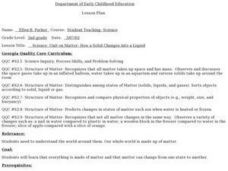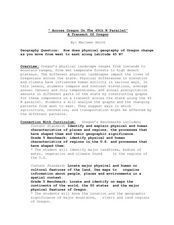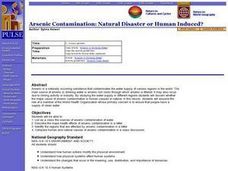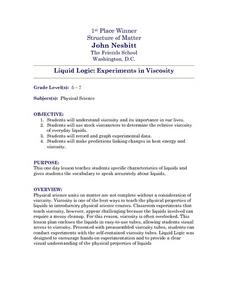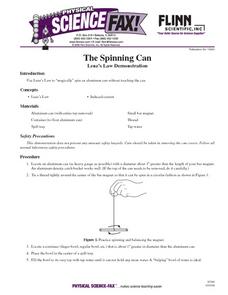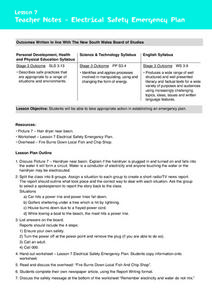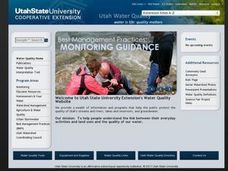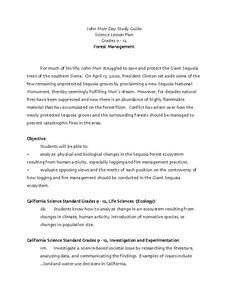Curated OER
Food and Fiber: Helping the Environment and You
Fourth graders explore the many uses of corn-based products and the importance of water resources. They consider how biodegradable products help to keep water clean. They perform experiments to observe how corn pellets dissolve while...
Science Matters
Thermal Energy Flow in Materials
The sun sends the earth 35,000 times the amount of energy required by all of us on the entire planet, every day. The fourth lesson in the 10-part series looks at how light energy from the sun transfers into thermal energy. Scholars build...
Curated OER
Postcards from California: A Unit on Geography, Social Studies, History and California's Resources
Fourth graders examine patterns that influence population density in the various regions of California. The unit's three lessons utilize graphic organizers for the interpretation and presentation of data.
Curated OER
Good Vibrations
Students demonstrate sound waves and make changes in the waves
resulting in changes in pitch. Students associate changes in pitch in various "musical instruments"with size and shape and the sound waves they produce.
Curated OER
Teaching about the Chemistry of Oxygen Solubility
Students explore solubility of gases in water, Henry's Law, LeChatelier's Principal, and supersaturation of gases in water.
Curated OER
Ammonium Nitrate - Heat of Solution
Students quantify the relationship between temperature, energy and heat
and define an endothermic reaction. They measure the energy change caused by dissolving one mole of ammonium nitrate in water.
Curated OER
Life in Extreme Environments - Lakes Under Ice
High schoolers collect chemical, physical, and biological data from a local lake throughout the year. In addition, students discuss the design of an experimental structure for water collection at several specific depths as well as assess...
Curated OER
Brine Shrimp 1: Hatching Brine Shrimp
Students review their prior knowledge on brine shrimp. In groups, they raise a group of brine shrimp and design an artificial environment in which they can live. They change the conditions of the environment to see how the shrimp react...
Curated OER
Science: How Solids Become Liquids
Second graders discover how matter changes from one state to another by observing melting ice cubes. They decide on means to warm the ice and predict what will happen. Students record how long it takes for the cubes to melt.
Curated OER
Oceanography
Fifth graders study the topography of the ocean floor. They determine its ever changing nature as they examine currents and trade winds. They write paragraph describing how the winds might affect land formations after the discussion of...
Curated OER
"Across Oregon On The 45th N Parallel" A Transect of Oregon
Students explore the physical geography of Oregon. In groups, students collect weather and elevation information on Oregon. They organize the data and create maps and graphs of the information. Afterward, students compare the...
Curated OER
Brine Shrimp Survival
Students develop an understanding of how growth and survival of an organism depends on physical conditions. They design an artificial environment in which brine shrimp can thrive. Students determine the optimum salinity for hatching of...
Curated OER
Arsenic Contamination: Natural Disaster or Human Induced?
Students list as a class the sources of arsenic contamination of water. They describe the major health effects of arsenic contamination in a letter. Students identify the regions that are affected by it.
Curated OER
How Things Fly
Middle schoolers conduct a series of hands-on experiments that help them explain the role of lift in fixed-wing flight. They observe the flow of air and water around several surfaces and then consider the dynamics of airflow around an...
Curated OER
Forest Management
Young scholars analyze physical and biological changes in the Sequoia forest ecosystem, especially logging and fire management practices. They evaluate the controversy of how logging and fire management should be conducted in the Giant...
Curated OER
What's the Matter with My Orange?
Students use oranges to informally explore decomposition, dehydration, fermentation, the water cycle, bacteria, yeast, food webs, the needs of living things, and physical vs. chemical change over a period of three or more months.
Curated OER
Liquid Logic: Experiments in Viscosity
Middle schoolers examine specific characteristics of liquids through a hands-on lab activity. An experiment with teacher prepared viscosity tubes is conducted in which liquid identities are predicted based on data. A hypothesis is...
Curated OER
Chasing El Nino
In this El Nino learning exercise, students review this specific change in the climate cycle by completing 20 short answer questions.
Curated OER
Science and Technology
Eighth graders explore the roles of science and technology in today's world. They research a topic based on the uses of science in society. Students discuss medicine, power, transportation, water and sewage treatment and stereos, TVs....
Curated OER
Making Paper
Students create paper by adding a few small scraps of paper into the blender pitcher and adding just enough water to thoroughly soak paper.
Curated OER
Science: Lenz's Law and the Spinning Can
Students observe a demonstration of Lenz's Law using an aluminum can and a bar magnet. They hypothesize what will occur as the can is placed in water and the magnet is lowered above it on a string. Students discover the phase shift...
Curated OER
Electrical Safety Emergency Plan
Students discuss Picture 7 which is a hairdryer near a basin. They discover that if the hairdryer is plugged in and turned on and falls into the water it will form a circuit and anyone touching the water or hairdryer may be electrocuted....
Curated OER
That Is Predictable
Students investigate the changes that can take place in an aquatic environment. They conduct research using a variety of resources. The research is used to report different possibilities of change because of abiotic or biotic factors.
Curated OER
Forest Management
Learners explore the changes in the Sequoia forest ecosystem. They evaluate reasons for the changes and discuss opposing views of human activity, logging and fire management practices. Students observe a video, describe the location of...










